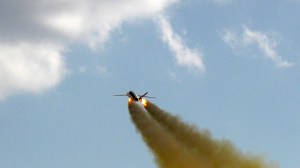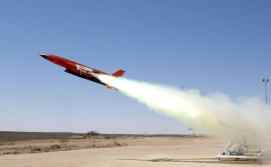Valkyrie drone links with F-35s as Marines pursue ‘autonomous collaborative killer’ capability

The Marine Corps’ latest flight testing of its jet-powered XQ-58A Valkyrie drone saw the system use common tactical data links to share targeting information with F-35 stealth fighters, according to the service.
The event, which occurred earlier this month during the annual Emerald Flag joint exercise at Eglin Air Force Base, Florida, comes as the Corps is conducting research, development, test and evaluation for its Penetrating Affordable Autonomous Collaborative Killer-Portfolio (PAACK-P) program, and the U.S. military writ large is pursuing new manned-unmanned teaming capabilities and next-generation drones known as collaborative combat aircraft.
The Valkyrie, built by Kratos, “effectively demonstrated its capabilities as a forward deployed sensing platform — providing critical threat targeting data to Marine Corps fifth-generation aircraft to rapidly close advanced kill chain,” the Marines said in a release Thursday announcing the results of the flight test, adding that it “contributed broad airborne and surface sensor awareness information to multiple ground and airborne joint network participants.”
The drone is 30 feet long with a 27-foot wingspan; has a dry weight of 2,500 pounds; 600-pound internal payload capacity; Mach 0.72 cruise speed; and maximum range of approximately 3,000 nautical miles, according to a Kratos data sheet. It costs a few million dollars per platform.
The uncrewed system was originally developed for the Air Force Research Lab’s Low Cost Attritable Aircraft Technology (LCAAT) initiative, and it has also participated in AFRL’s Skyborg program aimed at furthering technology for autonomous systems and robotic wingmen.
In December 2022, the Pentagon announced that the Department of the Navy had awarded a $15.5 million contract to Kratos for two Valkyries.
A year ago, the Marines kicked-off light testing of the system for the PAACK-P initiative.
A second test was conducted in February. In a release announcing the successful completion of that event, the Corps referred to the system as a “highly autonomous, low-cost tactical unmanned air vehicle.”
The third test, which occurred in September, added Link-16 capabilities.
In a statement, Col. Derek Brannon, branch head for the Cunningham Group, deputy commandant for aviation, said the most recent demonstration that happened this month focused on the use of tactical data links to enable digital communication between the XQ-58A, a four-ship of F-35Bs from Marine Fighter Attack Squadron 214 and other aircraft from the joint force.
“This test flight marked the capstone event for the PAACK-P Rapid Defense Experimentation Reserve project and proved the tactical utility of uncrewed offboard sensing platforms,” Lt. Col. Bradley Buick, the Cunningham Group’s future capabilities officer, said in a statement.
The Marines planned to conduct six flight tests of the drone for the program, officials said last year.






